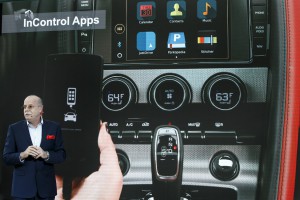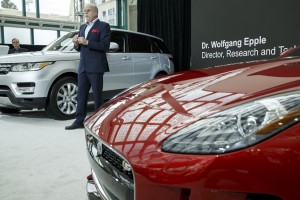
Wolfgang Epple, director of Research and Technology at Jaguar Land Rover, shows how the company's new technology displays and implements apps.
New technology that is being refined continuously now has the potential to make driving safer and more fun, while bringing the automobile business closer to the ever-blooming consumer electronics industry, executives from Volvo, Jaguar Land Rover and Audi said during the “Connected Car” expo that opened ahead of the 2014 Los Angeles Auto Show.
As evidence of that growing relationship, Jaguar Land Rover (JLR) is opening its $3 million Open Software Technology Center. The facility will focus on the development and application of advanced connected technologies and help lead the development of future Jaguar and Land Rover infotainment systems, according to Wolfgang Epple, director of Research and Technology, Jaguar Land Rover
The new technical center, the only JLR research center outside Great Britain, was located on the West Coast to development infotainment systems for all Jaguar and Land Rover vehicles.
JLR is in the midst of launching a new platform called justDrive that integrates popular apps and services such as Twitter, Spotify and Yelp, which will offer Jaguar and Land Rover customers access to more information will reducing distraction. The just Drive platform is now ready for Apple iOS8 user and will also be available on Android phones in early 2015.

Jaguar Land Rover's Wolfgang Epple discusses the use of technology to produce safer, yet more interactive new vehicles.
“Our InControl system already allows the driver to plug their smartphone into the vehicle and then safely control their apps through the vehicle’s touchscreen,” Epple said. ”The apps are enhanced for in-car use, so it is like having your smartphone installed in your dashboard.”
The ultimate objective is to take some of the fun people have with their individual smart phones and bring it into the vehicle in a safe way, noted Peter Virk, who is director of connected car development at JLR.
Virk said the new system, which was developed with the help of California-based Cloud Car, offers drivers full control of a phone’s aggregated app content and music through a natural speech or a common touch interface.
Audi highlighted its collaboration with another California-based company Nvidia, which is well known for is graphics technology.
The Audi-Nvidia collaboration is currently working on what Mathias Halliger of Audi described as in the industry first virtual cockpit, which will debut in the all-new 2016 Audi TT. The virtual cockpit replaces the instrument cluster with a central, digital unit that combines the functions of traditional gauges with the central multimedia interface in 12.3-inch TFT display with 3D graphics.
A quad-core “Tegra 30” processor from NVIDIA capable of rendering up to 60 frames per second ensures that the needles of the speedometer, rev counter and navigation are displayed with absolute precision, according to NVidia.
(New car sales could hit 17 million next year. For more, Click Here.)
Also on display was the zFAS computing module, which serves as the brains of Audi piloted driving.
Danny Shapiro, Nvidia’s director of automotive marketing, said advancements in the size and efficiency of the zFAS central control unit have resulted in a module that is now the size of a compact laptop with the same processing architecture that powers 10 of the world’s most energy-efficient supercomputers.
(Click Here for details about Audi’s new edgy Prologue.)
In the future the system can be used to drive a vehicle’s driver assistance technology and bring automated driving closer to reality because of its ability to meld data from various channels such radar, cameras and sensors. It can also be update with new features every few months without ripping up the entire dashboard, he said.
Hakan Samuelson, chief executive of Volvo Cars, said over the years Volvo has conducted extensive accident research and has invariably found that accidents invariably caused by human error. Automated system, such as those that Volvo is introducing on the new XC90, has the potential to eliminate human error.
(Mazda6 gets makeover for 2016. Click Here for the report.)
Samuelson added that Volvo expects to have 100 fully automated vehicles ready for tests in Sweden in 2017 and hopes to deploy automated driving system by 2020.
“Since driver error is the cause of almost accidents, if we could automate driving we could eliminate accidents,” he said.

Thanks for that one.